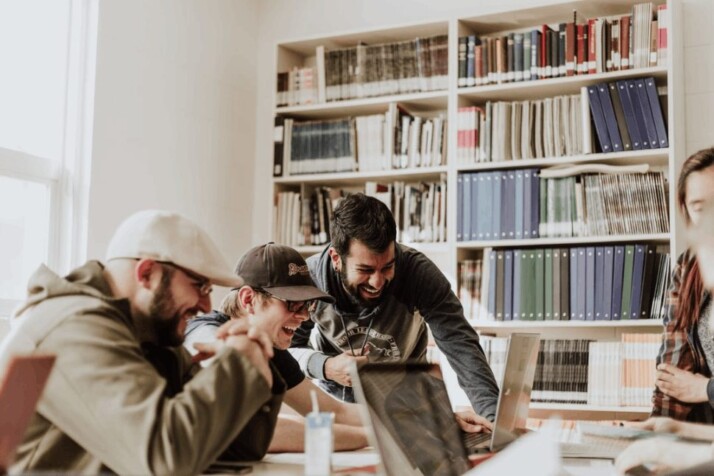Collaboration is “working together on a task,” while plagiarism is “copying someone else’s work and presenting it as your own.” The difference between collaboration and plagiarism becomes significant as it affects the acceptance and grading of papers.
What is Plagiarism?
Plagiarism is using another person’s work as your own and claiming that it is original. It occurs when one uses the text or ideas of a previously published work and turns it into their own. A typical example is using portions of other people’s work without giving credit.
Individuals who paraphrase an author’s work without proper citations and acknowledgment are also guilty of plagiarism. When a student plagiarizes, they try to pass off someone else’s ideas or writing as theirs. Plagiarism is common in academic writing, and attracts severe penalties.
What is Collaboration?
Collaboration is a way to help one become knowledgeable and provide oneself with an understanding of the content of an assignment. It means that a project becomes the product of a joint effort. Collaboration does not involve copying or claiming to have the sole authorship of a work.
The use of collaboration when writing an assignment is recommended. It makes it possible to share one’s ideas, thoughts, opinions, and research with others.
The disadvantage of collaboration is that no one can claim the assignment as the sole author.

When is Collaboration Appropriate?
Collaborations, group works, and discussions among students are good and highly encouraged. However, they are only allowed to occur in certain situations, such as in-class discussions, group projects/assignments, and exam/test study groups.
At the same time, barriers and halts are put on other collaborations (such as during assessments and exams). Collaboration that occurs during classroom assessments is considered cheating or plagiarism. It involves copying someone else’s work and presenting it as yours.
While students mustn’t copy and paste each other’s content, it is also fruitful for them when they discuss assignments. They can use assistance from their peers to understand a concept better. Students who work on their research essays on chosen topics can share their work with their peers, asking for feedback, input, or guidance. – This is an acceptable form of collaboration. It should be done openly and with transparency.
How Can the Collaborative Process be Effective?
Students can communicate more efficiently across distances without conflicting schedules with tools like Google Drive. The instructor can see their collaborative efforts using Google Drive’s “revision history” feature and track quality more than quantity.
There’s also a method to verify and ensure that every student engages in the collaborative process. The instructor can know who logged into the system and accessed the assignment and who didn’t. This allows the instructor to follow up with the faulting student and discuss their reasons for not participating in the project with other students.
Difference Between Collaboration and Plagiarism
Collaboration is when the content developed is created by more than one person. In the process of collaboration, content is often edited, rewritten, and improved by different individuals. On the other hand, plagiarism is the act of using other people’s content without giving credit.
Collaboration is when you share your work with others after taking steps to ensure your work is original. Plagiarism is when you present someone else’s work as your own without taking note that it is not your work.
Collaboration is a partnership between two or more people. It is as essential as teamwork because it allows for a multidisciplinary approach to problem-solving.
The idea of collaboration is that team members work together to produce a greater result than the sum of its parts. Plagiarism, on the other hand, is the act of taking intellectual property for one’s use without the knowledge or approval of the owner.
To Wrap Up
Plagiarism, often referred to as copying or stealing someone else’s work without giving them credit, is a substantial academic concern. It is not allowed and is against the law.
On the other hand, collaboration is working with a team to create a unique work. The people involved share credit for the work completed.
Explore All Plagiarism Checker Articles
Plagiarism in Journalism: Its Meaning and How to Avoid It
Writing is a wide array of interests that covers different professions and passions. In terms of news writing, journalists should…
The Difference Between Plagiarism and Appropriation in Art
People confuse the difference between plagiarism and appropriation. What they don’t understand is that these two terms differ from one…
6 Ways to Write Plagiarism Free Content — A Bloggers Guide
Generating unique plagiarism free content is one of the most important factors for optimizing your content and achieving higher SERP…
Using Plagiarism Checkers for Research Papers
With the web being so vast and expansive, it’s no wonder more, and more people are turning to it for…
6 Best Free Plagiarism Checker Online
What is the best free plagiarism checker today? You might have a paper or assignment due in the upcoming day,…
How to Copy and Paste Without Plagiarizing
The copy and paste function in your word processor is powerful. It can save your lots of time. But it…
